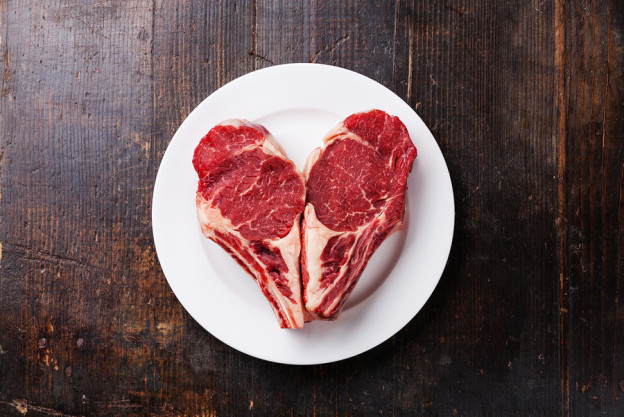By David Blyweiss, M.D., Advanced Natural Wellness
January 24, 2020
Unless you’re a vegan or vegetarian, I’ll bet you enjoy sitting down to eat a nice beef tenderloin, prime rib or rack of lamb every now and then.
While I’ve been limiting my intake of meat to around 10% of the plate every two or three days, I still enjoy it on occasion.
My absolute favorite is grass-fed New Zealand lamb. I pierce the top of the meat with a series of holes and fill each opening with a clove of garlic. Then, I cover the entire thing with organic ketchup to keep it moist and pop it into the oven.
Oh my word! It’s absolutely delicious. The garlic caramelizes, the ketchup keeps it moist and gives it a little shell. When you slice into it, the meat’s soft, rich, delicious and moist.
If you’ve never had it, you need to give it a try.
Another meat I’ve recently developed a taste for is prairie-raised bison – buffalo meat. It has a similar flavor to beef, but I find it to be a little bit richer… maybe even a little sweeter.
MD Exposes the Hidden Danger to Your Eyes

When your eyesight starts to fail, it's a real problem. Suddenly you can't go to the grocery store... you can't get to the doctor if you have an emergency... you can't meet your friends for dinner…
Your "regular" doctor doesn't have time to keep up with the latest research. And the same goes for eye doctors. They go to school to learn how to fit you for glasses and contacts, but have no way of preventing the damage and loss of eyesight that threatens your freedom and independence.
Let me show you something that explains a LOT about how your eyes work.
In my FREE Special Report, I'll show you a HUGE, untapped resource for your eyes that safely and naturally restores clear, effortless eyesight.
Click here to get started...
For buffalo, I like to braise it with wine and shallots, mushrooms, and rosemary. Braising is a healthier option because it keeps the meat soft and you won’t have the carcinogens that are created from meat blackened on a grill.
However, it’s not just the taste that makes bison a home run in my book. It also comes with a nutritional profile that exceeds most other animal proteins available to you.
You see, unlike today’s cattle, free roaming buffalo are much closer to the wild buffalo and other meat sources available to our ancestors. And even though buffalo themselves are huge, they’re actually much leaner than cattle. So the meat doesn’t contain nearly as much fat.
How Much Leaner is Buffalo Meat Compared to Beef?
Well, imagine sitting down to a juicy three and a half ounce burger. You have a choice between grass fed beef or grass fed bison.
If you choose the beef, you’ll get more than five times the amount of saturated fat than you would get from the bison. (The bison burger would have less than one gram while the beef would have about five.)
Now, I’m not saying you shouldn’t eat grass fed beef. It’s a good choice… when eaten in moderation. And it’s a much better choice over factory raised beef being fed GMO corn and being pumped full of antibiotics and hormones.
But if beef is a mainstay in your diet, this difference in fatty content could make a world of difference to your health. Especially if you’re still eating commercial beef.
You see, eating beef on a regular basis interferes with your arterial function. It also raises your levels of two inflammatory markers; C-reactive protein (CRP) and interleukin-6 (IL-6). These proteins are bad news. They’re linked to heart disease, cancer, Alzheimer’s and other inflammatory diseases.
Are You Suffering From...
- Love handles and a pot belly
- Romance that isn't what it used to
- Forgetfulness and inattention
- Low (or no) strength and endurance
- A sex drive that's shifted into neutral...or worse
If so...you may have Mature Male Burnout. Click here to discover more about this unique condition and what you can do about it.
But what happens when you regularly eat bison instead of beef?
No increase in arterial problems. No rise in inflammatory markers. No increased risk of heart disease or clogged arteries.
In other words, it’s an even healthier red meat! If you haven’t tried grass fed bison yet, I recommend it.
Down here in South Florida, I can pick it up at my local Whole Foods store. Even Publix carries it. But if you live off the beaten path, you may need to order it online.
To help you out, I talked to the folks at Wild Idea Buffalo Company. I don’t have any affiliation with them, but wanted to check them out. These folks raise 100% grass fed buffalo on the wide-open prairies of South Dakota. And all of the animals are antibiotic, hormone and grain free.
You can order online, or give them a call. (You’ll actually get somebody on the other end of the phone!)
Once you place your order, they’ll pack it up in an insulated cooler with dry ice and frozen gel packs. They’ll also send you an email with the expected delivery date.
But I do have one warning: The delivery isn’t always quick. It’s not because they aren’t working hard. It’s because they want your meat to arrive in perfect condition. So they only ship on Mondays, Tuesdays and Wednesdays.
This prevents your shipment from sitting in a FedEx or UPS warehouse over the weekend. (Of course, for a fee you can always get express delivery.)
Cooking Tips for Bison Meat
Now, one last thing…
You can’t treat your bison the way you would beef. It’s a very lean meat, so it cooks quickly. It requires about one-third less heat during cooking – and cooks in about one-third less time.
The more delicate cuts (ribeye, filet mignon, etc) are great broiled or grilled. When broiling, lower the oven rack a little further than you would for beef. For grilling, let the coals die down a bit before cooking. It only takes about five to eight minutes on each side (depending on thickness) to reach medium rare.
Roasts, briskets and short ribs require a longer cooking time at even lower heat. I’m sure if you get creative, you can find all sorts of interesting cooking tips and recipes on the internet.
And remember… keep your meat consumption – including bison – to only about 13% or less of your diet. It shouldn’t take up the most room on your plate. Fill the rest with fresh vegetables, fruits, beans and nuts. What’s at the end of your fork can be more powerful than what’s in a prescription bottle.
Sources:
National Nutrient Database for Standard Reference Release 28. United States Department of Agriculture. Last accessed Dec 2015.
Santos S, et al. Saturated fatty acids intake in relation to C-reactive protein, adiponectin, and leptin: a population-based study. Nutrition. 2013 Jun;29(6):892-7.
McDaniel J, et al. Bison meat has a lower atherogenic risk than beef in healthy men. Nutr Res. 2013 Apr;33(4):293-302.







